Chess IoT
Dhruv Rastogi1 , Jayati Bhardwaj Abhinav Gupta Ravish Dubey1Student of Computer Science Engineering, MIT Moradabad, U.P, India

2Faculty of Computer Science Engineering, MIT Moradabad, U.P, India ***
Abstract - This paper presents the design and development of an electronic Chess board with embedded LEDs and magnetic sensors. The board is capable of detecting and displaying the possible moves of a piece when lifted, along with other Chess rules. The project was completed by an individual with no prior experience in electronics hardware or software development under his teachers’ guidance, using an Arduino microcontroller and coded in C++. Technical challenges included scaling the number of sensors and LEDs, managing the 64 sensors and RGB LEDs with limited Arduino I/O pins, and implementing the various rules of chess. The resulting electronic Chess board is portable, features a traditional look with a wooden frame and painted glass top, and has a power bank with up to 5 hours of supply output. Its features include chess rules like hit another piece, castling, check, pawn switch at the end, and en-passant etc. Overall, this project provides an example of how emerging technologies can be used to enhance and modernize traditional games while providing a unique and interactive experience for players.
Key Words: Arduino Mega, Shift Register, Hall Sensors, LEDs, 8x8 LED Matrix, Power Bank
1. INTRODUCTION
The game of chess has been a symbol of strategy, logic,andcompetitionforcenturies.Ithasbeenstudiedby mathematicians, computer scientists, and psychologists to understanditscomplexityandbeauty.Inrecentyears,the rise of open-source hardware and software has made it possible for enthusiasts and students to create their own versions of electronic chess boards that can visualize and analyse the game in new ways. In this research paper, we present a novel approach to building an electronic chess board that uses magnetic sensors and LED displays to provide real-time feedback on the moves and rules of the game.
TheChessProjectwasinitiatedasapersonalchallengeby an individual with no previous experience in hardware programming or electronics. The goal was to create a portable and traditional-looking chess board that could detect the movement of every piece, display the possible moves,andenforcetherulesofchess.Theprojectinvolved learning and using Arduino microcontrollers, C++ programming language, magnetic sensors, and RGB LEDs.
It also required a systematic and iterative approach to design, build, and test the hardware and software components. The result was a functional and aesthetically pleasingchess board thatcouldbe powered by a portable battery and programmed further. The Chess Project not only demonstrates the feasibility and creativity of individual projects but also the potential of interdisciplinary research and education in engineering and game theory. The following sections will describe the design and implementation of the Chess Project in more detailandevaluateitsperformanceandlimitations.
2. NEED OF THE PROJECT
Theprimaryaimofthisprojectwastoexplorethe integration of hardware and software by developing an electronicchessboardwithembeddedLEDsandmagnetic sensors. The objective was to create a classic-looking chessboardthatnotonlydisplaysthepotentialmovesofa piece when lifted but also covers other game regulations. Theprojectwasinitiatedduetothelack ofaccessibleand portablechessboardsthatcouldexhibitthegame'smoves and rules. Traditional chess boards often require physical chesspiecesandaseparatemanualtodisplaytherulesof the game, which makes them inconvenient and bulky to carry around. Therefore, the project aimed to create a portable and all-in-one chess board that is easy to carry, enjoyable to play, and can be programmed for future updates. The project also provided a valuable learning experience for the individual to develop their skills and enhancetheirknowledgeinthisfield.
3. RELATED WORK
Related work on chess projects exists in various forms, including hardware and software implementations. SparkFun Electronics, a popular YouTube channel that provides tutorials and reviews of electronics projects, has alsodevelopedachessboardusinghardwarecomponents, including LEDs and sensors. The SparkFun chess board cantrackpiecesanddisplayingpossiblemoves,andituses aweb-basedinterfacetocontrolthegame.However,their project uses a different approach, with multiple boards connected via Wi-Fi and a computer program that managesthegamelogic.
4. FORMATION OF THE PROJECT
This project is classified into several parts for better understandingthecomponentsoftheproject.

4.1 Hardware Design
An essential aspect of this project was the mechanical design of the chess board. To achieve portability, a woodenframewasusedwithapaintedglasstopthatgives it a classic appearance. The board had dimensions of 40 cm x 40 cm and was 5 cm in height. It consisted of 64 squares, each measuring 3.5 cm x 3.5 cm, with 32 lightcolored squares and 32 dark-colored squares. The board wasequipped with 64RGB LEDs,withone LEDdedicated toeachsquare,arrangedinan8x8matrixandconnected to an Arduino I/O pin. The game pieces used were magnetic and had a diameter of 2 cm with a thickness of 0.5cm.Themagnetsweredesignedtobestrongenoughto allowthesensorsto detect them beneaththeglassduring gameplay, while also ensuring that they did not attract or repeleachother.Themechanicaldesignofthechessboard was carefully considered to ensure that it was not only visually appealing but also practical for use in playing chess.
4.2 Electronic Structure
4.2.1 Project Components
1. Arduino Mega Board
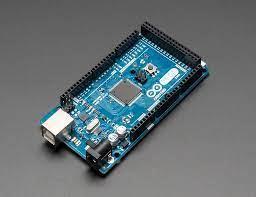
The project utilized an Arduino Mega microcontroller boardastheprimaryhardwarecomponent.ArduinoMega is an open-source platform that provides a simple and easy-to-use interface for building interactive electronic devices. It is designed with a larger number of digital and analog input/output pins compared to the basic Arduino board, which was essential for controlling the 64 RGB LEDs and 64 magnetic sensors in the chess board. The board runs on a 16MHz clock speed and features 256 KB offlashmemory,whichwassufficienttostoreandexecute the code for implementing the game's rules and moves. The board's USB interface allowed for convenient uploading of code, which was programmed using the Arduino Integrated Development Environment (IDE) and writtenintheC++language. TheuseoftheArduinoMega board was integral to the project, as it provided an efficientandcost-effectivesolutionforinterfacingwiththe hardwarecomponentsandimplementingthegamelogic.
2. Magnetic Hall Sensor
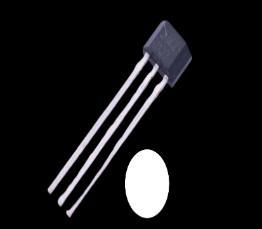
In this project, the Hall Sensor A3144 was utilized as a magnetic sensor to detect the presence and movement of chess pieces on the board. This sensor functions as a digital switch that triggers when a magnetic field of adequatestrengthisdetectedperpendiculartoitssurface. The A3144 sensor is a unipolar sensor that responds to south pole magnetic fields and has an open collector output. To provide a logic signal, an external pull-up resistor is necessary. The sensor's output is connected to the microcontroller's input for further processing. The A3144 sensor has low power consumption, high sensitivity, and is useful in a wide range of applications, including position sensing, speed measurement, and control. In this project, sixty-four A3144 sensors were used, with one sensor dedicated to each square on the chess board, ensuring accurate detection of the chess pieces' movement and allowing the system to display the possiblemoves.
3. LEDs Strip
TheLEDstripusedintheprojectistheWS2812b,whichis a popular RGB LED strip that allows individual control of each LED. The WS2812b LED strip is made up of small
LEDs that can be individually programmed with the help ofamicrocontroller.Thestripisflexibleandcanbecutto anylength,makingitaperfectfitforthisproject.EachLED on the strip contains a red, green, and blue LED, allowing forarangeofcolorstobedisplayed.Thestripiscontrolled using a single data wire and a power supply, making it simple to integrate with the Arduino Mega used in the project.TheWS2812bLEDstripprovidesaneffectiveway todisplaythepossiblemovesofachesspieceina visually appealingmanner.
Thechesspiecesusedintheprojecthavebeenmodifiedto incorporatemagnets,whichenable the Hall effectsensors to detect the presence or absence of the pieces on the board.Themagnetswerechosentoensurethatthepieces do not attract or repel each other, which could result in errors or malfunctions in the system. The integration of magnets into the chess pieces was a crucial step in the development of the project, as it allowed for precise tracking of piece movements without requiring the use of cameras or other sophisticated hardware. The use of magneticpiecesalsomakesthesystemmoreintuitiveand user-friendly, as it closely resembles the traditional method of playing chess. Overall, the use of integrated magneticpiecesisakeyaspectoftheprojectthatenables it to provide an engaging and authentic chess-playing experience.
component of the design, allowing for accurate and reliabledetectionofthemagneticpiecesontheboard.


In this project, a total of 64 10Kohm resistors were used. These resistors were employed as voltage dividers to measure the voltage output of the Hall sensor, which was used to detect the presence of magnetic chess pieces. The resistors were chosen for their ability to handle a wide range of voltages and currents, while also being reliable andinexpensive.Eachresistorwascarefullysolderedonto the circuit board, ensuring that there were no cold solder joints or other defects that could compromise the performance of the circuit. The use of 64 resistors may seem excessive, but it was necessary to ensure that each square of the chessboard was accurately represented in thecircuit.Overall,theuseof10Kohmresistorswasakey
Forthisproject,weuse5Vpowersupplypowerbankand it is needed to power the various electronic components used.Toensureportabilityandeaseofuse,arechargeable power bank was used as the power supply. The power bank can provide a stable 5V output, ensuring that the chess board functions correctly without any issues. The powerbankcanberechargedeasilyusingaUSBcableand canlastforseveralhours,allowingforextendedperiodsof use without needing to recharge. This setup also eliminatestheneedforanyexternalpowersource,making the chess board more convenient and practical to use. Additionally, the use of a rechargeable power bank promotes eco-friendliness by reducing the need for disposable batteries or mains power supply, making it a moresustainableoptionforpoweringthechessboard.
7. PCB Board
The Printed Circuit Board (PCB) plays a vital role in the successful operation of the electronic chess board. The design of the PCB includes multiple layers and contains thenecessarycomponentstocontrolthemovementofthe chess pieces. The PCB is the central component that connects all of the sensors and LED strips, making it a crucial part of the overall design. Using a premanufactured PCB board not only helped to reduce the overallcostoftheproject,butalsomadeitmucheasierto design and assemble. The use of PCBs ensures that the circuitryiswell-organizedandcompact,allowingformore precise and efficient movements of the chess pieces. The PCBs were designed to be 8 x 8 cm in size, which fit the dimensions of the chess board, making it easier to integrateintothefinaldesign.TheuseofPCBsallowsfora more efficient and robust design, which is crucial for the successfulimplementationoftheelectronicchessboard.
8. Shift Register
In the project, we used eight 74HC165 8-bit shift register to read the status of each chessboard square. The shift registertakesinaserialdatastreamand outputsthedata

inparallel.Byusingthiscomponent, wecan minimize the number of digital input pins needed on the microcontrollertoreadthechessboard'sstatus.Withonly three digital input pins, we can read the status of all 64 squares. The 74HC165 is a cost-effective and widely available component, making it an ideal choice for this project.Weusedfourshiftregisterstoreadthestateofall squares on the chessboard. The data from these shift registers was then sent to the microcontroller for processing and analysis. The use of the shift register greatly simplifies the design of the electronics and makes iteasiertointerfacewiththemicrocontroller.
thechessboardsquares. Thisgridwasplacedunderneath the glass board, which allowed for easy detection of the magnetic chess pieces. The design of the sensor assembly and the PCB boards allowed for easy assembly and maintenance, ensuring that the system was reliable and easytouse.
Fig
4.2.2 LEDs Integration
Inthisprojectthe64LEDsareconnectedtoeachother in seriesandareplacedaboveeachhallsensor,showninFig. 6.
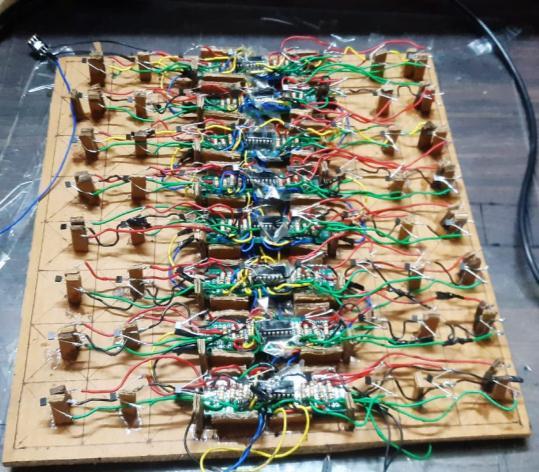
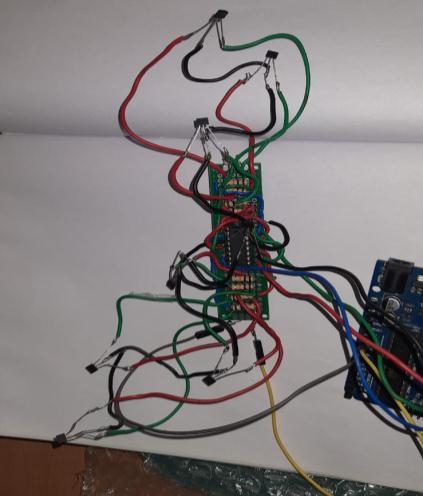
Fig
:Hallsensor,ICandResistors
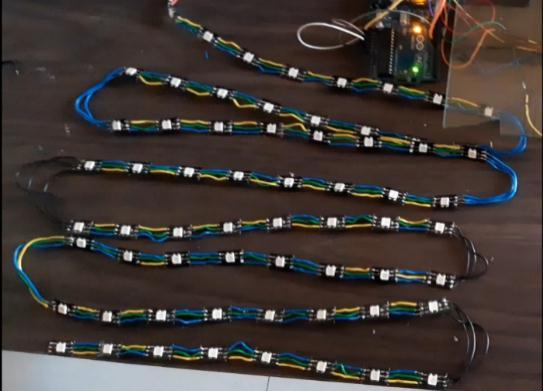


4.2.4 PCB Board Assembly
The 64hall sensorsareassembled on 8x8 cm PCB boards with8hall sensorsandeight10kohmresistorsconnected toeachboard.The74HC1658-bitshiftregistersaredaisy chained with each other. This configuration allows for all 64 hall sensors to be connected to only 4 pins on the Arduino, making the wiring simple and clean. The shift registers convert the 8-bit parallel data from the hall sensors into serial data that is sent to the Arduino. This reduces the number of pins required for the connection and provides a more efficient and organized way of connectingmultiplesensorstotheArduino.The5Vpower supplyisprovidedbyarechargeablepowerbank.
4.2.3 Hall Sensors Assembly
For the magnetic piece detection, eight A3144 Hall Effect sensors were used. These sensors were connected to a 74HC165 8-bit shift register which allowed for eight sensors to be connected to only three Arduino pins. The sensor assembly was mounted on a 8 x 8 cm PCB board witheachsensorhavingitsown10Kohmresistor,tolimit the current flowing through the sensors. By connecting multiplesensorstoa singleshiftregister,wewereable to significantly reduce the number of pins needed to detect the position of the chess pieces. The sensors were arranged in a 8 x 8 grid, corresponding to the position of
5. CIRCUIT DESIGN
Fig -9:CircuitDesignof1PCB
The 8 hall sensors on the PCB board are connected to a single 8-bit shift register, along with 8 resistors. The shift register requires only 4 pins to communicate with the Arduino- a clock pin, a clock enablepin, a loadpin,and a datapin.Thesepinsenabletheshiftregistertoreceiveand store8bitsofdatafromthehallsensors,andthentransfer this data to the Arduino through the data pin. The clock pin is used to synchronize the transfer of data, while the clock enables, and load pins are used to control when the shift register is enabled to receive data and when it is outputting data to the Arduino. By using a shift register, we are able to significantly reduce the number of pins required to interface with the hall sensors, which simplifiestheoveralldesignandreducesthecomplexityof thewiring.

6. PROJECT FLOW

6.1 Project Flow
The Chess IoT project is a combination of chess and technology to create an interactive and intelligent chess game. The pieces are equipped with magnets that are detected by hall sensors beneath the board. The game is controlled by an Arduino microcontroller that runs an algorithmtodisplaythepossiblemovesofthepiecesusing LEDs.Thegamestartsbyplacingthepiecesattheirinitial positions.
One of the innovative features of the Chess IoT project is the LED display. An LED on the side of the white player glows, indicating that it is white's turn to make a move. Whenaplayerliftsapiece,theLEDsonthesquareswhere that piece can move light up, making it easier for the playertodecidetheirmove.Astheplayerplacesthepiece onanyof the possiblemoves,all theLEDSturnoff.ALED on white player side turns off, and a LED on the black playersideturnson,representingtheturnofblack.
TheChessIoTprojectfollowstherulesofchess,including check, castling, switching to queen when a pawn reaches the other end, en-passant, and hitting another piece. The algorithmrunningontheArduinomicrocontrollerhandles the game's rules and displays the possible moves of the pieces.TheLEDsontheboardmakeiteasytovisualizethe possiblemovesandtakestrategicdecisions.
AnotherexcitingfeatureoftheChessIoTprojectisthatthe usercanchangethecolouroftheLEDsbypressingthe8x8 LEDmatrix,whichhasbeendesignedtoworkasabutton. By pressing the matrix, the LEDs beneath the chessboard change colour, and players can select the color of their choice.
Thegameisplayedonapre-manufacturedPCBboardwith 64 hall sensors assembly connected with 8 shift registers and resistors on 8 PCB boards. The shift registers are daisy-chained with each other so that only four pins are connected to the Arduino. The 5V power supply is provided by a rechargeable power bank. The Chess IoT projectalsofeaturesintegratedchesspieceswithmagnets, ensuringthatthesensorsbeneaththeglasscandetectthe magneticpieces.Themagnetsarestrongenoughtoensure thatthepiecesdonotrepelorattracteachother.
Overall,theChessIoTprojectisafascinatingcombination ofchessandtechnologythattakesthegametoanewlevel. It provides players with a unique and interactive way to play chess while still following the traditional rules of the game. The LED display makes it easier to visualize the possiblemovesofthepieces,andtheabilitytochangethe LEDcoloursaddstothegame'sappeal.Withitsinnovative
features,theChessIoTprojectisafunandexcitingwayto enjoythegameofchess.
displaying a message on the LED matrix, the players can quicklyandeasilydeterminethewinnerofthegame.
6.3 Hit another piece
When the board displays the possible moves of a piece, and the player wishes to capture an opponent's piece, the player must first lift the piece that will be captured and remove it from the board. The player can then place the piece that will capture the opponent's piece in the square wherethecapturedpiecewaslocated.Thismoveisknown as "hit another piece" or "capturing" and is one of the fundamentalrulesofchess.Inourproject,thehallsensors detect the presence or absence of magnetic pieces on the board, which allows for accurate tracking of piece movements, including capturing. The Arduino software canrecognizewhenacapturehasoccurredandupdatethe game state accordingly. The LED display can be used to indicate which piece has been captured and help players keep track of the game's progress. By implementing this feature in our chess IoT project, we have created a more realisticandengaginggameexperienceforplayers.
6.2 Check-mate Condition
The winning condition in chess is simple: the player who checkmates the opponent's king wins the game. Checkmateisa situationin whichtheking isina position to be captured (in check) and there is no legal move that can be made to escape capture. The game ends immediatelywhencheckmateisachieved.
However, in some cases, the game may end in a draw. Thereareseveralwaysinwhichadrawcanbedeclaredin chess,suchaswhenneitherplayerhasenoughmaterialto checkmate, when the same position is repeated three times, or when both players agree to a draw. These rules helppreventgamesfromdraggingonendlessly.
In this project, the winning condition is detected by the software running on the Arduino. When a player checkmates the other player's king, the Arduino sends a signaltotheLEDmatrixtodisplayamessagedeclaringthe winner. The message will be displayed until the board is resetbytheplayersforthenextgame.

It's important to note that the chess pieces used in this project are the same as those used in a standard chess game.Theonlydifferenceisthattheyhavebeenmodified with magnets for the purpose of detecting their position on the board. This means that the rules of chess are the sameandthesamestrategiescanbe employedtowinthe game.
Overall, the winning condition in this project is a critical component of the chess IoT system. It provides a clear indicationoftheoutcomeofthegameandensuresthatthe rules are followed properly. By detecting checkmate and

6.4 Check
Inthe game ofchess, when a player'skingisunderattack by an opponent's piece, it is known as "check." This is a crucial aspect of the game as it signifies the potential captureoftheking,leading totheloss ofthegame.Inour IoT-based chess set, wehave incorporated a blinking LED beneath the king's position that glows when the king is under check. This not only adds a visually appealing feature to the game but also alerts the player to take immediate action to defend their king. The player must move their king out of the path of attack, block the attack with another piece, or capture the opponent's piece to eliminate the threat of check. Failing to do socould result in a checkmate, which would lead to the loss of the game. Thus, the check feature serves as a critical element of the game and requires players to be strategic in their moves andalwayskeepthesafetyoftheirkinginmind.
6.5 En-Passant
En-passant is a special move in chess that can only be made by a pawn, which allows the pawn to capture an opponent'spawnthathasjustmovedtwosquaresfromits initial position and passed beside it. The capturing pawn movesdiagonallytothesquaretheopposingpawnpassed over, and the captured pawn is removed from the board. To execute en-passant,thecapturingpawn must beonits fifth rank, and the opposing pawn must be adjacent to it. Thismoveisdesignedtopreventtheopposingplayerfrom evading capture by moving two squares at once. In this project, the en-passant move has been implemented by checkingthepositionofeachpawn,andtheboardupdates automaticallywheneverthemoveisexecuted.Thisfeature
adds an extra level of complexity to the game and encourages players to think strategically and anticipate theiropponent'smoves.

6.6 Pawn Switch
Inthegameofchess,thepawnswitchisanessentialmove thatallowsapawntoreachtheotherendoftheboardand transformintoastrongerpiece.Whenapawnreachesthe eighthrank,ithastheoptiontopromoteitselftoa queen, rook, bishop or knight, thus becoming a more powerful pieceontheboard.Thismovecanbea gamechangerand hasoftenbeenusedincriticalmomentstoturnthetideof thegameinthe player'sfavor.Itisimportant to notethat thepawnswitchmustfollowtherulesofchessandcannot promote to a king or another pawn. With the use of the magnetic pieces and sensors, the pawn switch is accuratelytrackedontheLEDboardand addsan exciting element to the game. The LED matrix also allows for the player to easily select the desired piece for promotion, making the pawn switch an intuitive and accessible feature. Overall, the pawn switch is an essential aspect of chess and adds a layer of complexity and strategytothegame.

6.7 Castling
Inchess,castlingisamovethatallowsthekingandarook to move at the same time. However, castling is only allowed if certain conditions are met, such as neither the king nor the rook have moved, there are no pieces between the king and the rook, and the king is not in check. In this project, the user can check if castling is possible by lifting the king piece first. If it is possible, the king is then placed on the other side of the rook, and the rook is lifted and placed next to the king. The rules of castlingarehandledbytheArduinoandtheshiftregisters.

This project uses an 8x8 LED matrix to display the game state and possible moves of each piece. When a player wants to castle, the LED matrix displays the possible moves of the king, and the user can lift the king to see if castling is possible. If castling is possible, the LED matrix updatestodisplaythenewpositionsofthekingandrook. The8hallsensorsandshiftregistersareusedtodetectthe positionsofeachpieceontheboard,allowingtheArduino to keep track of the game state and handle the rules of chess.
Castlingisanimportantmoveinchessasitallowstheking to move to a safer location while also activating the rook forfurtheruse inthegame. Withtheuse ofthischessIoT system, castling is made easier and more efficient, as the user can quickly check if castling is possible without having to physically move the pieces around the board. The system also ensures that the rules of castling are
followed correctly, preventing any potential cheating or misunderstandings.
Overall, the implementation of castling in this chess IoT system is an important feature that allows for more strategic gameplay and provides a more enjoyable experience for the users. The combination of hardware components, such as the hall sensors and shift registers, withtheArduinosoftwareallowsforefficientandaccurate detection of the positions of each piece on the board, makingcastlingandotherchessmovespossiblewithease.
7. CONCLUSION
In conclusion, the development of an Arduino-based chessboard that can detect and display the moves of the pieces on a computer screen has been successfully achieved. The integration of hall sensors, magnets, and LED strips in the mechanical design, as well as the use of shift registers and resistors on custom PCB boards, has allowed for accurate and efficient detection and communication of the chess moves to the computer. The use of C++ programming language on the Arduino platform has also enabled the implementation of various features, such as automatic move validation and multiple game modes, which enhance the user experience. The success of this project demonstrates the potential of
integrating hardware and software development in creatinginnovativeandpracticalsolutions.Thedeveloped chessboardcanbeusedforchessenthusiastswhowantto play online while retaining the traditional experience of usingphysicalchesspieces.Theprojectcanalsoserveasa basis for further development and customization for different applications. Overall, this project has not only achieveditsobjectivesbutalsoprovidedvaluablelearning experiencesintheareasof electronics,programming,and design.
8. FUTURE SCOPE
The incorporation of a speaker in the chess project can greatly enhance the user experience by providing audio feedback during gameplay. This feature can be programmedtoannouncethemovesmadebyeachplayer, highlight check, and checkmate situations, and even provide tutorial guidance for beginners. The speaker can also add an element of immersion to the game by playing sound effects that correspond to each piece moved, creatingamoredynamicandengagingchessexperience.
Byconnectingthechessprojecttotheinternet,playerscan participate in online matches and compete with other players from around the world. This feature can be implemented through the integration of a Wi-Fi module, enabling the chess board to communicate with online servers and provide a seamless online chess experience. Additionally, the project can be designed to allow for remote play, where players can connect to each other's boardsthroughtheinternetandplayagameofchessfrom differentlocations.
Playing against AI is an excellent way to improve chess skills and develop new strategies. By incorporating an AI feature into the chess project, users can play against computeropponentsofvaryingdifficultylevels,providing a challenging and engaging chess experience. This feature can also be used for training purposes, where users can analyse their gameplay and receive feedback on their moves. The integration of AI can be achieved through the use of machine learning algorithms and can be further enhancedby incorporating computervisiontechnology to trackthepiecesontheboard.
9. REFERENCES
[1] Intelligent Chessboard Using IOT 1Tejas Shaha, 2Deepak Chaudhari, 3Ashutosh Kshirsagar, 4Aboli Doiphode,5Prof.M.R.Mahajan1B.EStudent,2B.EStudent, 3B.E Student, 4B.E Student, 5Professor 1Department of Information Technology 1Pune Vidyarthi Griha’s College ofEngineeringandTechnology,Pune,India

[2] https://www.chess.com/forum/view/chess equipment/making-my-automatic-chessboard
[3]https://forum.arduino.cc/
[4] https://medium.com/@christopher.jamescooke/sma rt-chess-arduino-uno-50ddf488aeda
[5] The Role of Chess in Artificial Intelligence Research RobertLevinson(Chairperson)ComputerandInformation SciencesAppliedSciencesBuildingUniversityofCalifornia atSantaCruz,CA95064
[6]https://dronebotworkshop.com/shift-registers/
